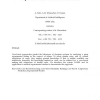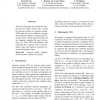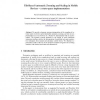SIMULATION
2011
14 years 1 months ago
2011
From a modelling and simulation perspective, studying dynamic systems consists of focusing on changes in states. According to the precision of state changes, generic algorithms ca...
CORR
2010
Springer
14 years 5 months ago
2010
Springer
Abstract. This paper aims at providing a rigorous definition of selforganization, one of the most desired properties for dynamic systems (e.g., peer-to-peer systems, sensor networ...
ARTMED
1999
14 years 6 months ago
1999
Case-based approaches predict the behaviour of dynamic systems by analysing a given experimental setting in the context of others. To select similar cases and to control adaptatio...
TSMC
2008
14 years 6 months ago
2008
The control of dynamic systems that undergo an impact collision is both theoretically challenging and of practical importance. An appeal of studying systems that undergo an impact ...
IJRR
2008
14 years 6 months ago
2008
: In this paper, we present a sampling-based verification algorithm for continuous dynamic systems with uncertainty due to adversaries, unmodeled disturbance inputs, unknown parame...
IJMMS
2008
14 years 6 months ago
2008
The dynamic systems approach to the design of continuous interaction interfaces allows the designer to use simulations, and analytical tools to analyse the behaviour and stability...
EUSFLAT
2003
14 years 8 months ago
2003
The aim of this paper is to present the Temporal Fuzzy Chains (TFCs) [3] to model the dynamic systems in a linguistic manner. TFCs make use of two different concepts: the traditio...
ISIPTA
2003
IEEE
14 years 12 months ago
2003
IEEE
Set-valued estimation offers a way to account for imprecise knowledge of the prior distribution of a Bayesian statistical inference problem. The set-valued Kalman filter, which p...
MHCI
2004
Springer
14 years 12 months ago
2004
Springer
Abstract. We provide a dynamic systems interpretation of the coupling of internal states involved in speed-dependent automatic zooming, and test our implementation on a text browse...
CDC
2008
IEEE
15 years 1 months ago
2008
IEEE
— This paper extends a method for integrating source-code model checking with dynamic system analysis to verify properties of controllers for nonlinear dynamic systems. Source-co...



